Individual Report: Business Environment Analysis for Sainsbury's
VerifiedAdded on 2020/12/31
|11
|3341
|477
Report
AI Summary
This report provides a comprehensive analysis of Sainsbury's business environment. It begins with an introduction to the concept of the business environment, outlining external forces impacting organizations like Sainsbury's, a major UK supermarket. The report then differentiates between various types of organizations (private, public, and voluntary sectors) and their distinct purposes, with a focus on Sainsbury's as a private sector entity. It then delves into stakeholder mapping, detailing the process of identifying and analyzing stakeholders to achieve business objectives, including the steps of determining, analyzing, and understanding key stakeholders. Furthermore, the report explores micro and macro industry analyses, utilizing tools like PESTLE, SWOT, and Porter's Five Forces to assess Sainsbury's external environment and competitive position. The PESTLE analysis examines political, economic, social, technological, legal, and environmental factors. The report concludes by emphasizing the importance of these analyses for Sainsbury's strategic decision-making and overall success in the competitive retail market.
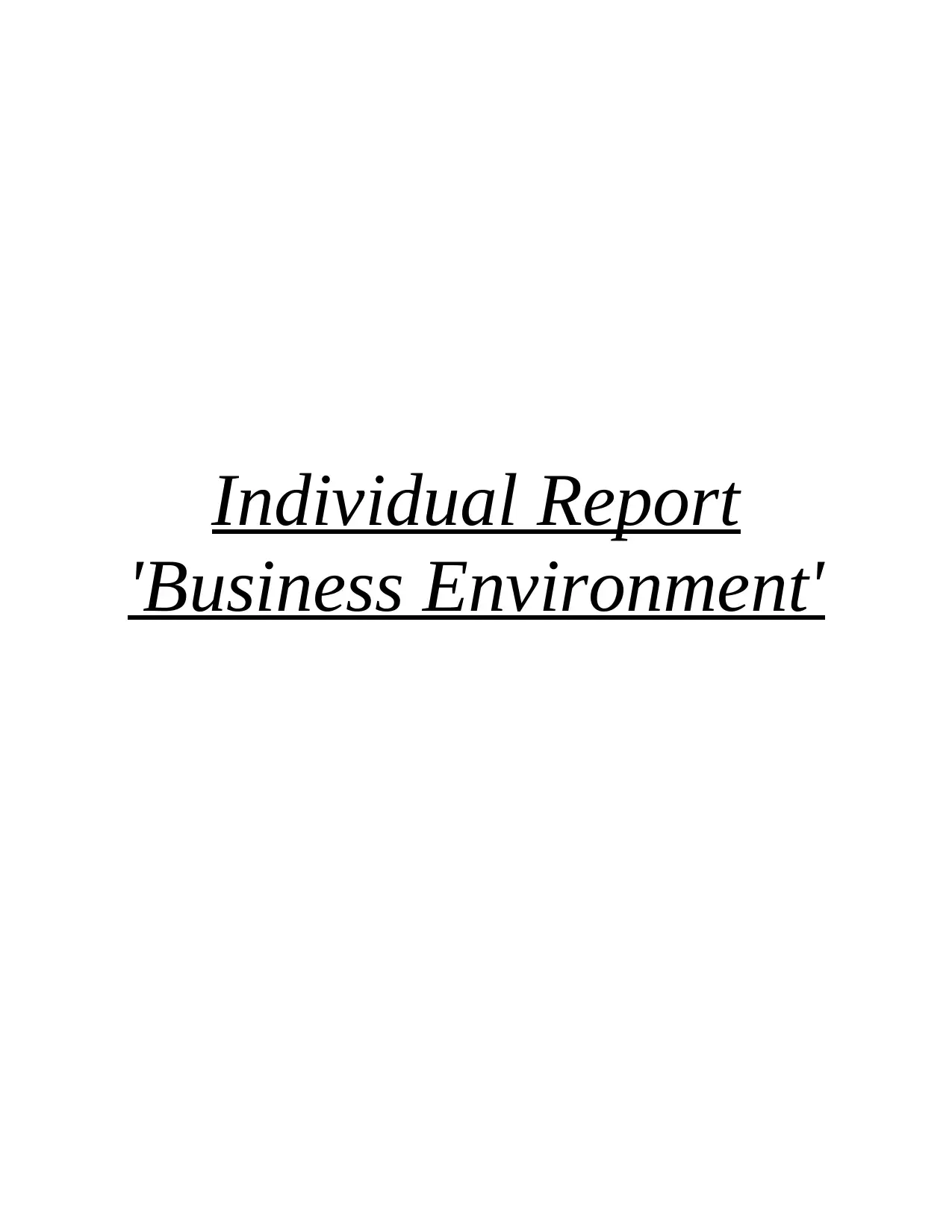
Individual Report
'Business Environment'
'Business Environment'
Paraphrase This Document
Need a fresh take? Get an instant paraphrase of this document with our AI Paraphraser
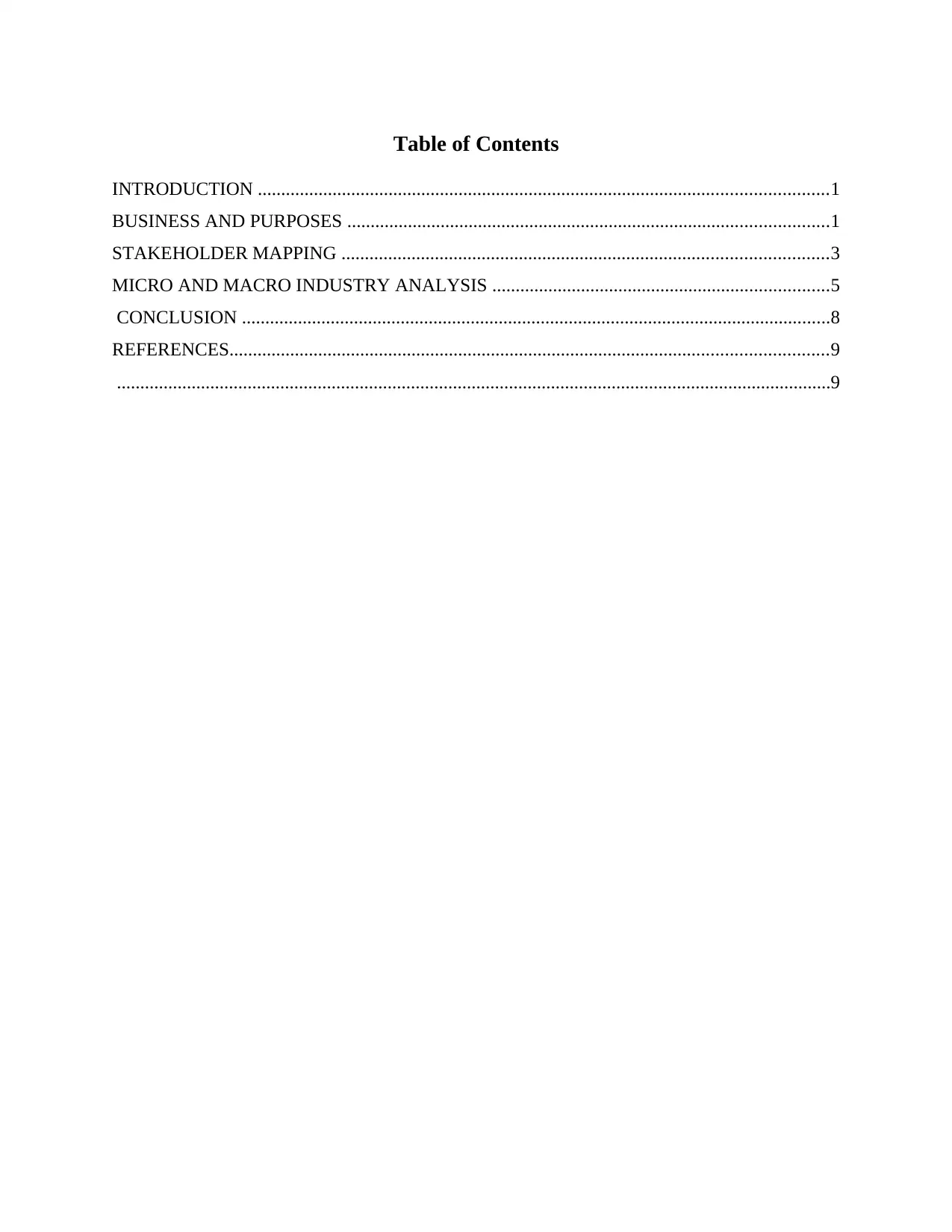
Table of Contents
INTRODUCTION ..........................................................................................................................1
BUSINESS AND PURPOSES .......................................................................................................1
STAKEHOLDER MAPPING ........................................................................................................3
MICRO AND MACRO INDUSTRY ANALYSIS ........................................................................5
CONCLUSION ..............................................................................................................................8
REFERENCES................................................................................................................................9
.........................................................................................................................................................9
INTRODUCTION ..........................................................................................................................1
BUSINESS AND PURPOSES .......................................................................................................1
STAKEHOLDER MAPPING ........................................................................................................3
MICRO AND MACRO INDUSTRY ANALYSIS ........................................................................5
CONCLUSION ..............................................................................................................................8
REFERENCES................................................................................................................................9
.........................................................................................................................................................9
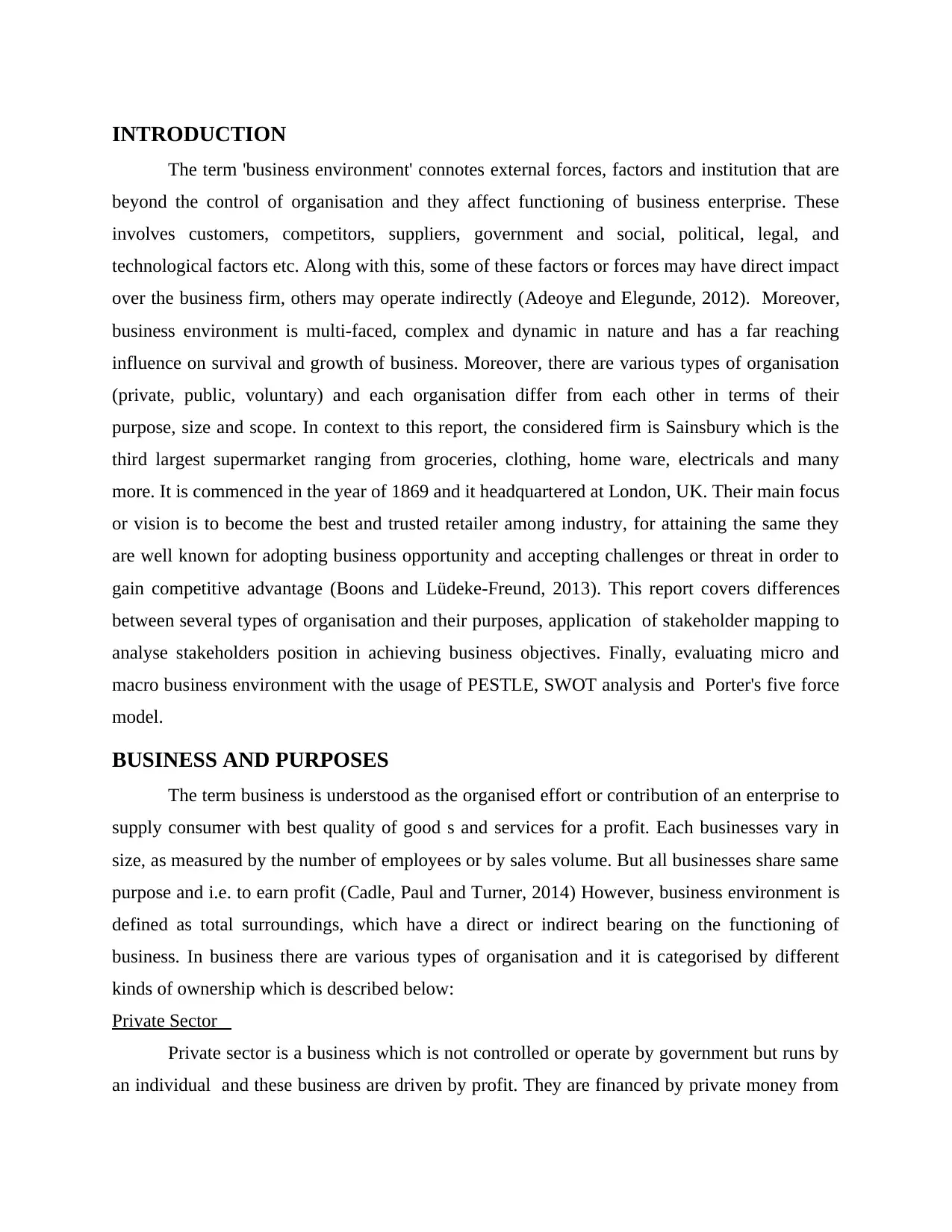
INTRODUCTION
The term 'business environment' connotes external forces, factors and institution that are
beyond the control of organisation and they affect functioning of business enterprise. These
involves customers, competitors, suppliers, government and social, political, legal, and
technological factors etc. Along with this, some of these factors or forces may have direct impact
over the business firm, others may operate indirectly (Adeoye and Elegunde, 2012). Moreover,
business environment is multi-faced, complex and dynamic in nature and has a far reaching
influence on survival and growth of business. Moreover, there are various types of organisation
(private, public, voluntary) and each organisation differ from each other in terms of their
purpose, size and scope. In context to this report, the considered firm is Sainsbury which is the
third largest supermarket ranging from groceries, clothing, home ware, electricals and many
more. It is commenced in the year of 1869 and it headquartered at London, UK. Their main focus
or vision is to become the best and trusted retailer among industry, for attaining the same they
are well known for adopting business opportunity and accepting challenges or threat in order to
gain competitive advantage (Boons and Lüdeke-Freund, 2013). This report covers differences
between several types of organisation and their purposes, application of stakeholder mapping to
analyse stakeholders position in achieving business objectives. Finally, evaluating micro and
macro business environment with the usage of PESTLE, SWOT analysis and Porter's five force
model.
BUSINESS AND PURPOSES
The term business is understood as the organised effort or contribution of an enterprise to
supply consumer with best quality of good s and services for a profit. Each businesses vary in
size, as measured by the number of employees or by sales volume. But all businesses share same
purpose and i.e. to earn profit (Cadle, Paul and Turner, 2014) However, business environment is
defined as total surroundings, which have a direct or indirect bearing on the functioning of
business. In business there are various types of organisation and it is categorised by different
kinds of ownership which is described below:
Private Sector
Private sector is a business which is not controlled or operate by government but runs by
an individual and these business are driven by profit. They are financed by private money from
The term 'business environment' connotes external forces, factors and institution that are
beyond the control of organisation and they affect functioning of business enterprise. These
involves customers, competitors, suppliers, government and social, political, legal, and
technological factors etc. Along with this, some of these factors or forces may have direct impact
over the business firm, others may operate indirectly (Adeoye and Elegunde, 2012). Moreover,
business environment is multi-faced, complex and dynamic in nature and has a far reaching
influence on survival and growth of business. Moreover, there are various types of organisation
(private, public, voluntary) and each organisation differ from each other in terms of their
purpose, size and scope. In context to this report, the considered firm is Sainsbury which is the
third largest supermarket ranging from groceries, clothing, home ware, electricals and many
more. It is commenced in the year of 1869 and it headquartered at London, UK. Their main focus
or vision is to become the best and trusted retailer among industry, for attaining the same they
are well known for adopting business opportunity and accepting challenges or threat in order to
gain competitive advantage (Boons and Lüdeke-Freund, 2013). This report covers differences
between several types of organisation and their purposes, application of stakeholder mapping to
analyse stakeholders position in achieving business objectives. Finally, evaluating micro and
macro business environment with the usage of PESTLE, SWOT analysis and Porter's five force
model.
BUSINESS AND PURPOSES
The term business is understood as the organised effort or contribution of an enterprise to
supply consumer with best quality of good s and services for a profit. Each businesses vary in
size, as measured by the number of employees or by sales volume. But all businesses share same
purpose and i.e. to earn profit (Cadle, Paul and Turner, 2014) However, business environment is
defined as total surroundings, which have a direct or indirect bearing on the functioning of
business. In business there are various types of organisation and it is categorised by different
kinds of ownership which is described below:
Private Sector
Private sector is a business which is not controlled or operate by government but runs by
an individual and these business are driven by profit. They are financed by private money from
⊘ This is a preview!⊘
Do you want full access?
Subscribe today to unlock all pages.

Trusted by 1+ million students worldwide
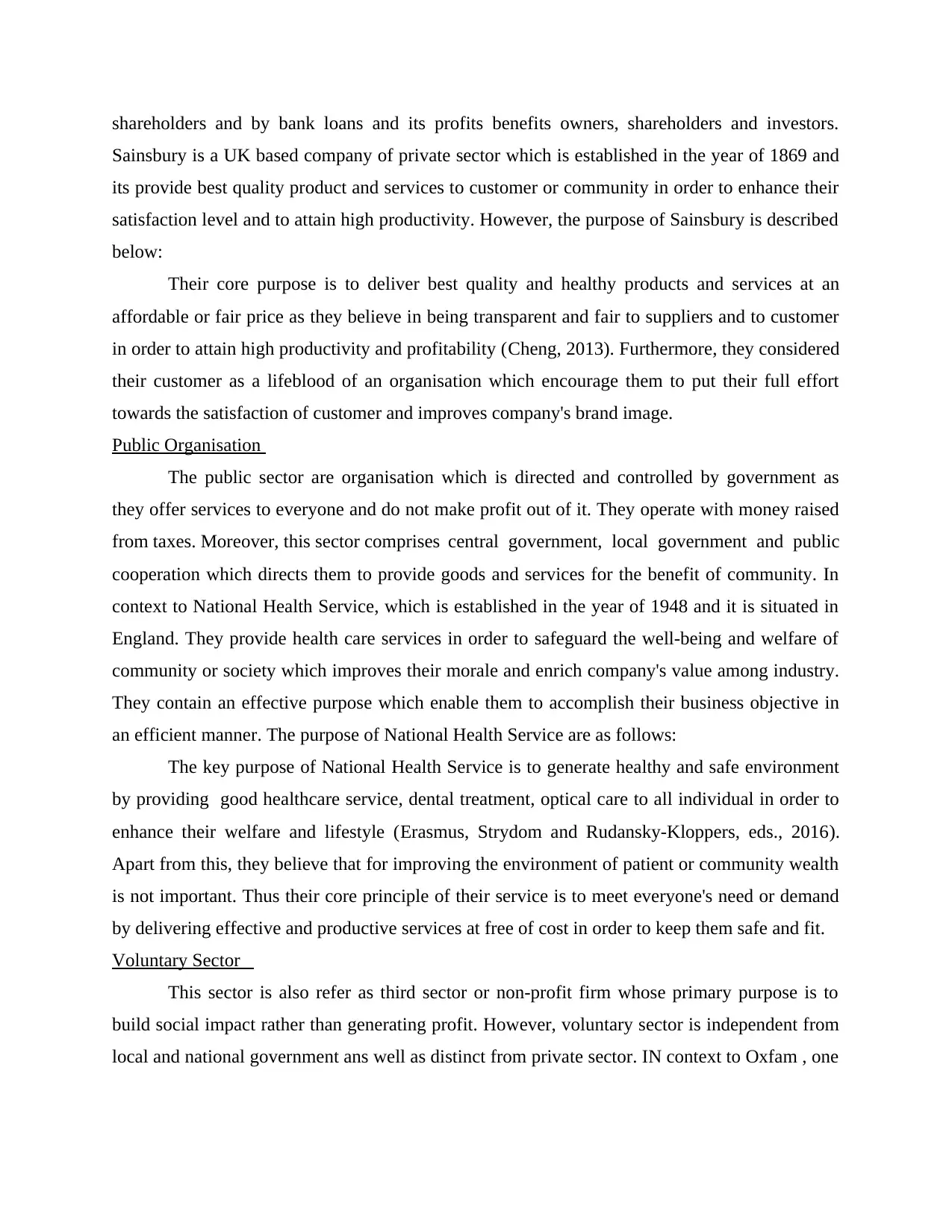
shareholders and by bank loans and its profits benefits owners, shareholders and investors.
Sainsbury is a UK based company of private sector which is established in the year of 1869 and
its provide best quality product and services to customer or community in order to enhance their
satisfaction level and to attain high productivity. However, the purpose of Sainsbury is described
below:
Their core purpose is to deliver best quality and healthy products and services at an
affordable or fair price as they believe in being transparent and fair to suppliers and to customer
in order to attain high productivity and profitability (Cheng, 2013). Furthermore, they considered
their customer as a lifeblood of an organisation which encourage them to put their full effort
towards the satisfaction of customer and improves company's brand image.
Public Organisation
The public sector are organisation which is directed and controlled by government as
they offer services to everyone and do not make profit out of it. They operate with money raised
from taxes. Moreover, this sector comprises central government, local government and public
cooperation which directs them to provide goods and services for the benefit of community. In
context to National Health Service, which is established in the year of 1948 and it is situated in
England. They provide health care services in order to safeguard the well-being and welfare of
community or society which improves their morale and enrich company's value among industry.
They contain an effective purpose which enable them to accomplish their business objective in
an efficient manner. The purpose of National Health Service are as follows:
The key purpose of National Health Service is to generate healthy and safe environment
by providing good healthcare service, dental treatment, optical care to all individual in order to
enhance their welfare and lifestyle (Erasmus, Strydom and Rudansky-Kloppers, eds., 2016).
Apart from this, they believe that for improving the environment of patient or community wealth
is not important. Thus their core principle of their service is to meet everyone's need or demand
by delivering effective and productive services at free of cost in order to keep them safe and fit.
Voluntary Sector
This sector is also refer as third sector or non-profit firm whose primary purpose is to
build social impact rather than generating profit. However, voluntary sector is independent from
local and national government ans well as distinct from private sector. IN context to Oxfam , one
Sainsbury is a UK based company of private sector which is established in the year of 1869 and
its provide best quality product and services to customer or community in order to enhance their
satisfaction level and to attain high productivity. However, the purpose of Sainsbury is described
below:
Their core purpose is to deliver best quality and healthy products and services at an
affordable or fair price as they believe in being transparent and fair to suppliers and to customer
in order to attain high productivity and profitability (Cheng, 2013). Furthermore, they considered
their customer as a lifeblood of an organisation which encourage them to put their full effort
towards the satisfaction of customer and improves company's brand image.
Public Organisation
The public sector are organisation which is directed and controlled by government as
they offer services to everyone and do not make profit out of it. They operate with money raised
from taxes. Moreover, this sector comprises central government, local government and public
cooperation which directs them to provide goods and services for the benefit of community. In
context to National Health Service, which is established in the year of 1948 and it is situated in
England. They provide health care services in order to safeguard the well-being and welfare of
community or society which improves their morale and enrich company's value among industry.
They contain an effective purpose which enable them to accomplish their business objective in
an efficient manner. The purpose of National Health Service are as follows:
The key purpose of National Health Service is to generate healthy and safe environment
by providing good healthcare service, dental treatment, optical care to all individual in order to
enhance their welfare and lifestyle (Erasmus, Strydom and Rudansky-Kloppers, eds., 2016).
Apart from this, they believe that for improving the environment of patient or community wealth
is not important. Thus their core principle of their service is to meet everyone's need or demand
by delivering effective and productive services at free of cost in order to keep them safe and fit.
Voluntary Sector
This sector is also refer as third sector or non-profit firm whose primary purpose is to
build social impact rather than generating profit. However, voluntary sector is independent from
local and national government ans well as distinct from private sector. IN context to Oxfam , one
Paraphrase This Document
Need a fresh take? Get an instant paraphrase of this document with our AI Paraphraser
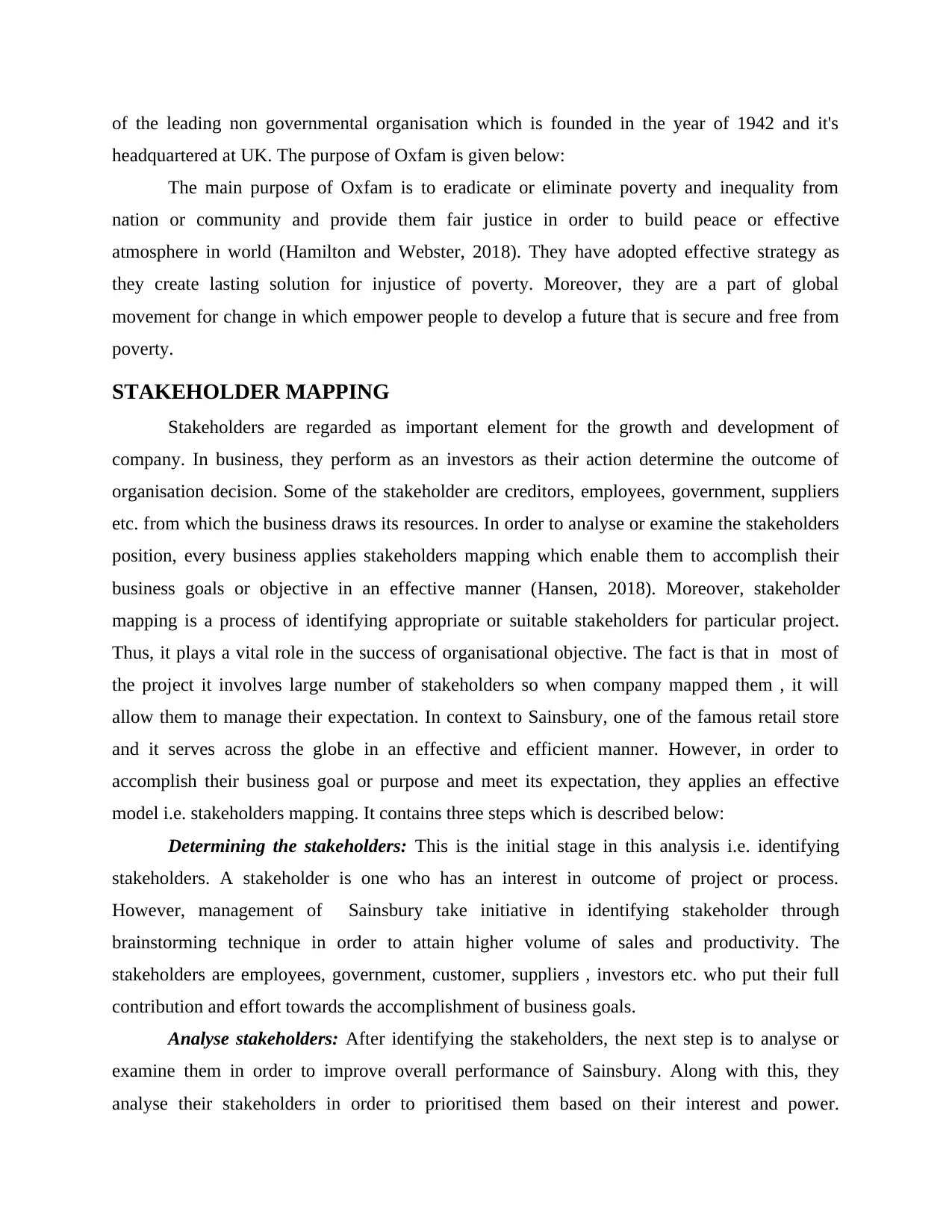
of the leading non governmental organisation which is founded in the year of 1942 and it's
headquartered at UK. The purpose of Oxfam is given below:
The main purpose of Oxfam is to eradicate or eliminate poverty and inequality from
nation or community and provide them fair justice in order to build peace or effective
atmosphere in world (Hamilton and Webster, 2018). They have adopted effective strategy as
they create lasting solution for injustice of poverty. Moreover, they are a part of global
movement for change in which empower people to develop a future that is secure and free from
poverty.
STAKEHOLDER MAPPING
Stakeholders are regarded as important element for the growth and development of
company. In business, they perform as an investors as their action determine the outcome of
organisation decision. Some of the stakeholder are creditors, employees, government, suppliers
etc. from which the business draws its resources. In order to analyse or examine the stakeholders
position, every business applies stakeholders mapping which enable them to accomplish their
business goals or objective in an effective manner (Hansen, 2018). Moreover, stakeholder
mapping is a process of identifying appropriate or suitable stakeholders for particular project.
Thus, it plays a vital role in the success of organisational objective. The fact is that in most of
the project it involves large number of stakeholders so when company mapped them , it will
allow them to manage their expectation. In context to Sainsbury, one of the famous retail store
and it serves across the globe in an effective and efficient manner. However, in order to
accomplish their business goal or purpose and meet its expectation, they applies an effective
model i.e. stakeholders mapping. It contains three steps which is described below:
Determining the stakeholders: This is the initial stage in this analysis i.e. identifying
stakeholders. A stakeholder is one who has an interest in outcome of project or process.
However, management of Sainsbury take initiative in identifying stakeholder through
brainstorming technique in order to attain higher volume of sales and productivity. The
stakeholders are employees, government, customer, suppliers , investors etc. who put their full
contribution and effort towards the accomplishment of business goals.
Analyse stakeholders: After identifying the stakeholders, the next step is to analyse or
examine them in order to improve overall performance of Sainsbury. Along with this, they
analyse their stakeholders in order to prioritised them based on their interest and power.
headquartered at UK. The purpose of Oxfam is given below:
The main purpose of Oxfam is to eradicate or eliminate poverty and inequality from
nation or community and provide them fair justice in order to build peace or effective
atmosphere in world (Hamilton and Webster, 2018). They have adopted effective strategy as
they create lasting solution for injustice of poverty. Moreover, they are a part of global
movement for change in which empower people to develop a future that is secure and free from
poverty.
STAKEHOLDER MAPPING
Stakeholders are regarded as important element for the growth and development of
company. In business, they perform as an investors as their action determine the outcome of
organisation decision. Some of the stakeholder are creditors, employees, government, suppliers
etc. from which the business draws its resources. In order to analyse or examine the stakeholders
position, every business applies stakeholders mapping which enable them to accomplish their
business goals or objective in an effective manner (Hansen, 2018). Moreover, stakeholder
mapping is a process of identifying appropriate or suitable stakeholders for particular project.
Thus, it plays a vital role in the success of organisational objective. The fact is that in most of
the project it involves large number of stakeholders so when company mapped them , it will
allow them to manage their expectation. In context to Sainsbury, one of the famous retail store
and it serves across the globe in an effective and efficient manner. However, in order to
accomplish their business goal or purpose and meet its expectation, they applies an effective
model i.e. stakeholders mapping. It contains three steps which is described below:
Determining the stakeholders: This is the initial stage in this analysis i.e. identifying
stakeholders. A stakeholder is one who has an interest in outcome of project or process.
However, management of Sainsbury take initiative in identifying stakeholder through
brainstorming technique in order to attain higher volume of sales and productivity. The
stakeholders are employees, government, customer, suppliers , investors etc. who put their full
contribution and effort towards the accomplishment of business goals.
Analyse stakeholders: After identifying the stakeholders, the next step is to analyse or
examine them in order to improve overall performance of Sainsbury. Along with this, they
analyse their stakeholders in order to prioritised them based on their interest and power.
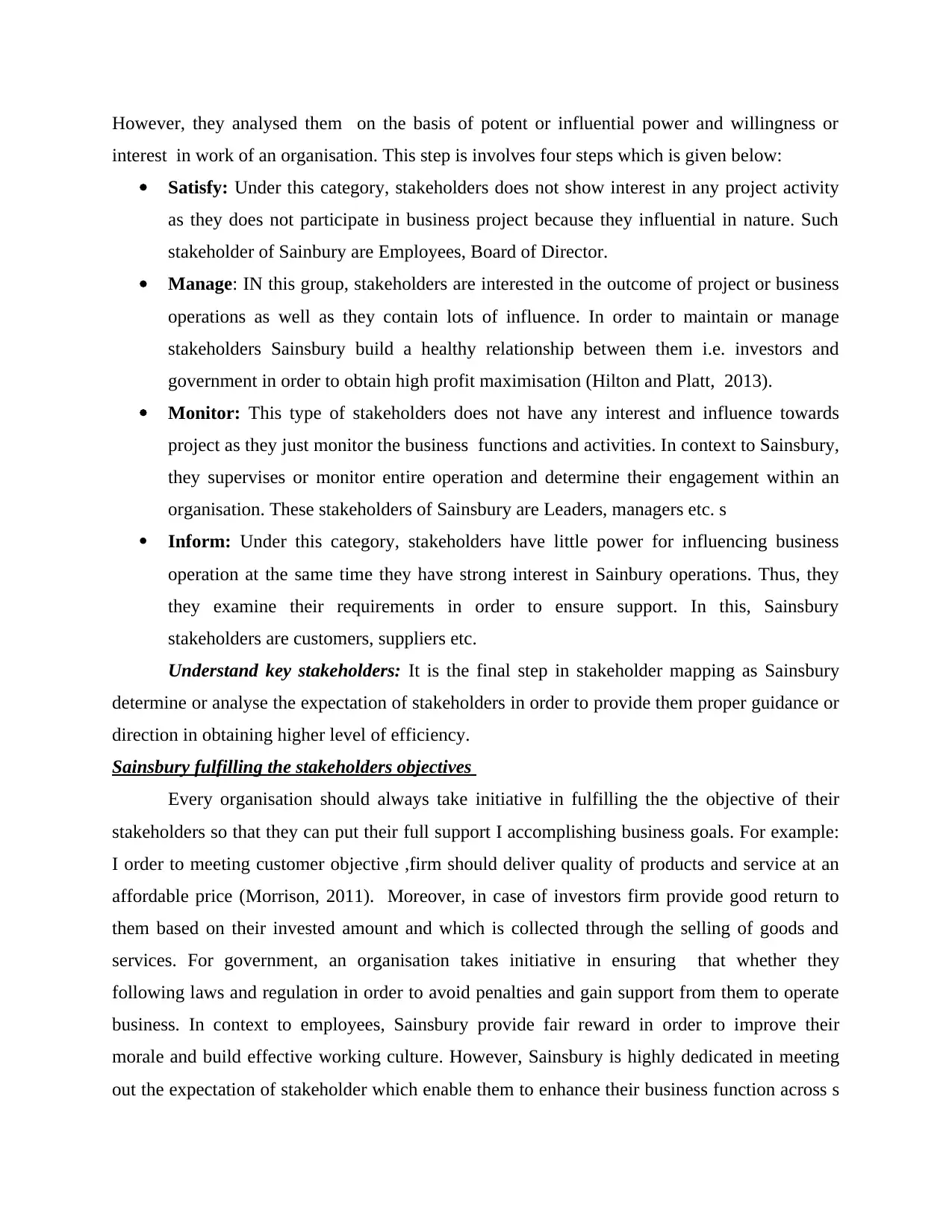
However, they analysed them on the basis of potent or influential power and willingness or
interest in work of an organisation. This step is involves four steps which is given below:
Satisfy: Under this category, stakeholders does not show interest in any project activity
as they does not participate in business project because they influential in nature. Such
stakeholder of Sainbury are Employees, Board of Director.
Manage: IN this group, stakeholders are interested in the outcome of project or business
operations as well as they contain lots of influence. In order to maintain or manage
stakeholders Sainsbury build a healthy relationship between them i.e. investors and
government in order to obtain high profit maximisation (Hilton and Platt, 2013).
Monitor: This type of stakeholders does not have any interest and influence towards
project as they just monitor the business functions and activities. In context to Sainsbury,
they supervises or monitor entire operation and determine their engagement within an
organisation. These stakeholders of Sainsbury are Leaders, managers etc. s
Inform: Under this category, stakeholders have little power for influencing business
operation at the same time they have strong interest in Sainbury operations. Thus, they
they examine their requirements in order to ensure support. In this, Sainsbury
stakeholders are customers, suppliers etc.
Understand key stakeholders: It is the final step in stakeholder mapping as Sainsbury
determine or analyse the expectation of stakeholders in order to provide them proper guidance or
direction in obtaining higher level of efficiency.
Sainsbury fulfilling the stakeholders objectives
Every organisation should always take initiative in fulfilling the the objective of their
stakeholders so that they can put their full support I accomplishing business goals. For example:
I order to meeting customer objective ,firm should deliver quality of products and service at an
affordable price (Morrison, 2011). Moreover, in case of investors firm provide good return to
them based on their invested amount and which is collected through the selling of goods and
services. For government, an organisation takes initiative in ensuring that whether they
following laws and regulation in order to avoid penalties and gain support from them to operate
business. In context to employees, Sainsbury provide fair reward in order to improve their
morale and build effective working culture. However, Sainsbury is highly dedicated in meeting
out the expectation of stakeholder which enable them to enhance their business function across s
interest in work of an organisation. This step is involves four steps which is given below:
Satisfy: Under this category, stakeholders does not show interest in any project activity
as they does not participate in business project because they influential in nature. Such
stakeholder of Sainbury are Employees, Board of Director.
Manage: IN this group, stakeholders are interested in the outcome of project or business
operations as well as they contain lots of influence. In order to maintain or manage
stakeholders Sainsbury build a healthy relationship between them i.e. investors and
government in order to obtain high profit maximisation (Hilton and Platt, 2013).
Monitor: This type of stakeholders does not have any interest and influence towards
project as they just monitor the business functions and activities. In context to Sainsbury,
they supervises or monitor entire operation and determine their engagement within an
organisation. These stakeholders of Sainsbury are Leaders, managers etc. s
Inform: Under this category, stakeholders have little power for influencing business
operation at the same time they have strong interest in Sainbury operations. Thus, they
they examine their requirements in order to ensure support. In this, Sainsbury
stakeholders are customers, suppliers etc.
Understand key stakeholders: It is the final step in stakeholder mapping as Sainsbury
determine or analyse the expectation of stakeholders in order to provide them proper guidance or
direction in obtaining higher level of efficiency.
Sainsbury fulfilling the stakeholders objectives
Every organisation should always take initiative in fulfilling the the objective of their
stakeholders so that they can put their full support I accomplishing business goals. For example:
I order to meeting customer objective ,firm should deliver quality of products and service at an
affordable price (Morrison, 2011). Moreover, in case of investors firm provide good return to
them based on their invested amount and which is collected through the selling of goods and
services. For government, an organisation takes initiative in ensuring that whether they
following laws and regulation in order to avoid penalties and gain support from them to operate
business. In context to employees, Sainsbury provide fair reward in order to improve their
morale and build effective working culture. However, Sainsbury is highly dedicated in meeting
out the expectation of stakeholder which enable them to enhance their business function across s
⊘ This is a preview!⊘
Do you want full access?
Subscribe today to unlock all pages.

Trusted by 1+ million students worldwide
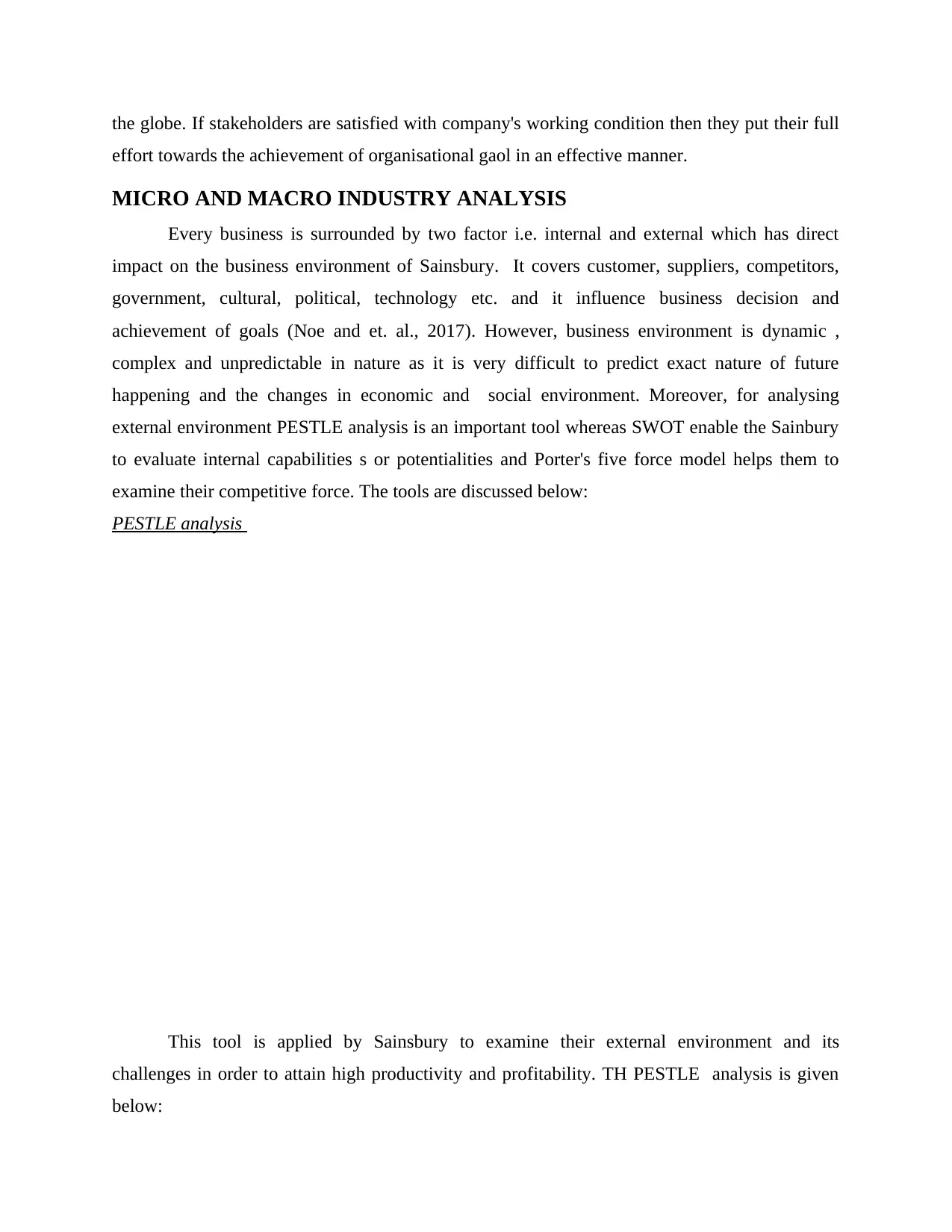
the globe. If stakeholders are satisfied with company's working condition then they put their full
effort towards the achievement of organisational gaol in an effective manner.
MICRO AND MACRO INDUSTRY ANALYSIS
Every business is surrounded by two factor i.e. internal and external which has direct
impact on the business environment of Sainsbury. It covers customer, suppliers, competitors,
government, cultural, political, technology etc. and it influence business decision and
achievement of goals (Noe and et. al., 2017). However, business environment is dynamic ,
complex and unpredictable in nature as it is very difficult to predict exact nature of future
happening and the changes in economic and social environment. Moreover, for analysing
external environment PESTLE analysis is an important tool whereas SWOT enable the Sainbury
to evaluate internal capabilities s or potentialities and Porter's five force model helps them to
examine their competitive force. The tools are discussed below:
PESTLE analysis
This tool is applied by Sainsbury to examine their external environment and its
challenges in order to attain high productivity and profitability. TH PESTLE analysis is given
below:
effort towards the achievement of organisational gaol in an effective manner.
MICRO AND MACRO INDUSTRY ANALYSIS
Every business is surrounded by two factor i.e. internal and external which has direct
impact on the business environment of Sainsbury. It covers customer, suppliers, competitors,
government, cultural, political, technology etc. and it influence business decision and
achievement of goals (Noe and et. al., 2017). However, business environment is dynamic ,
complex and unpredictable in nature as it is very difficult to predict exact nature of future
happening and the changes in economic and social environment. Moreover, for analysing
external environment PESTLE analysis is an important tool whereas SWOT enable the Sainbury
to evaluate internal capabilities s or potentialities and Porter's five force model helps them to
examine their competitive force. The tools are discussed below:
PESTLE analysis
This tool is applied by Sainsbury to examine their external environment and its
challenges in order to attain high productivity and profitability. TH PESTLE analysis is given
below:
Paraphrase This Document
Need a fresh take? Get an instant paraphrase of this document with our AI Paraphraser
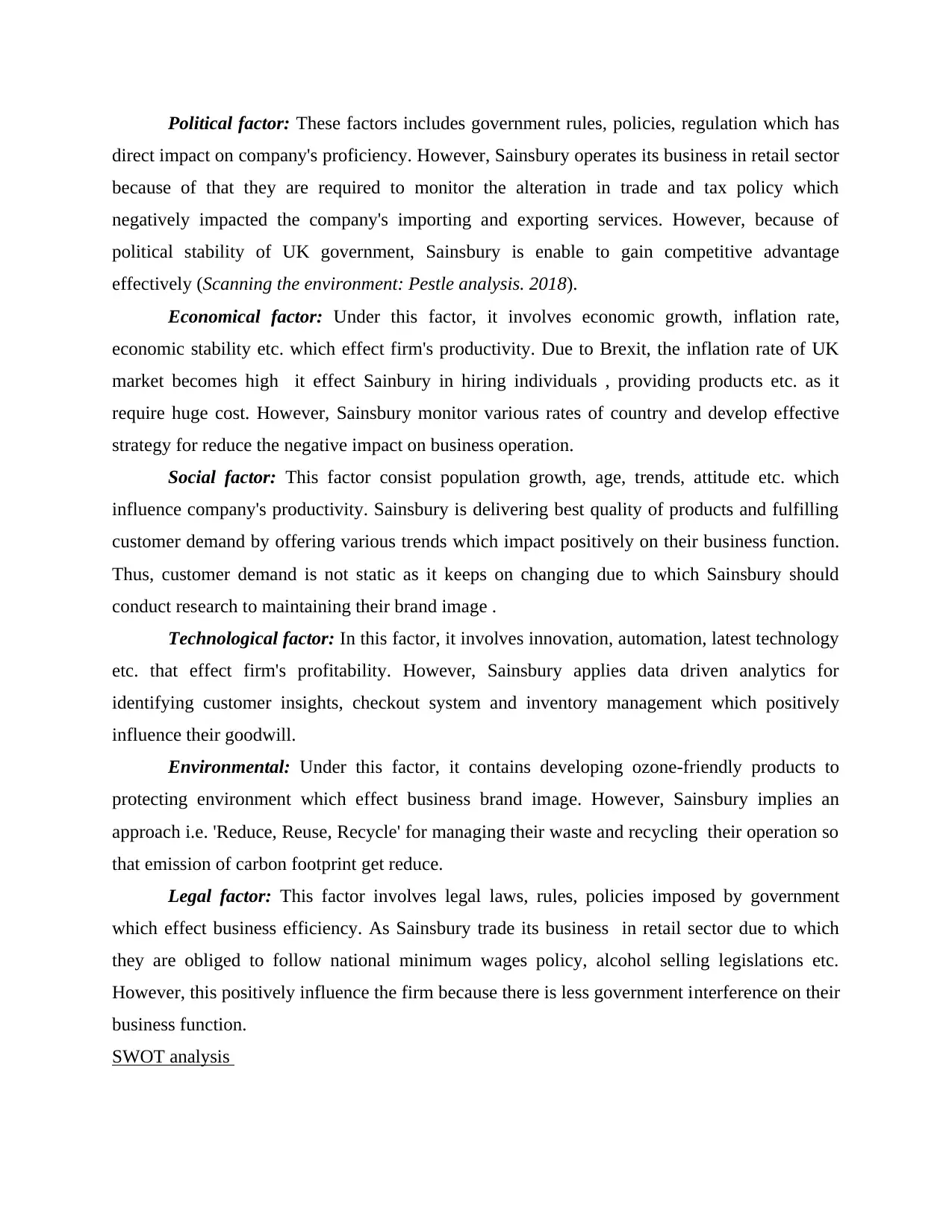
Political factor: These factors includes government rules, policies, regulation which has
direct impact on company's proficiency. However, Sainsbury operates its business in retail sector
because of that they are required to monitor the alteration in trade and tax policy which
negatively impacted the company's importing and exporting services. However, because of
political stability of UK government, Sainsbury is enable to gain competitive advantage
effectively (Scanning the environment: Pestle analysis. 2018).
Economical factor: Under this factor, it involves economic growth, inflation rate,
economic stability etc. which effect firm's productivity. Due to Brexit, the inflation rate of UK
market becomes high it effect Sainbury in hiring individuals , providing products etc. as it
require huge cost. However, Sainsbury monitor various rates of country and develop effective
strategy for reduce the negative impact on business operation.
Social factor: This factor consist population growth, age, trends, attitude etc. which
influence company's productivity. Sainsbury is delivering best quality of products and fulfilling
customer demand by offering various trends which impact positively on their business function.
Thus, customer demand is not static as it keeps on changing due to which Sainsbury should
conduct research to maintaining their brand image .
Technological factor: In this factor, it involves innovation, automation, latest technology
etc. that effect firm's profitability. However, Sainsbury applies data driven analytics for
identifying customer insights, checkout system and inventory management which positively
influence their goodwill.
Environmental: Under this factor, it contains developing ozone-friendly products to
protecting environment which effect business brand image. However, Sainsbury implies an
approach i.e. 'Reduce, Reuse, Recycle' for managing their waste and recycling their operation so
that emission of carbon footprint get reduce.
Legal factor: This factor involves legal laws, rules, policies imposed by government
which effect business efficiency. As Sainsbury trade its business in retail sector due to which
they are obliged to follow national minimum wages policy, alcohol selling legislations etc.
However, this positively influence the firm because there is less government interference on their
business function.
SWOT analysis
direct impact on company's proficiency. However, Sainsbury operates its business in retail sector
because of that they are required to monitor the alteration in trade and tax policy which
negatively impacted the company's importing and exporting services. However, because of
political stability of UK government, Sainsbury is enable to gain competitive advantage
effectively (Scanning the environment: Pestle analysis. 2018).
Economical factor: Under this factor, it involves economic growth, inflation rate,
economic stability etc. which effect firm's productivity. Due to Brexit, the inflation rate of UK
market becomes high it effect Sainbury in hiring individuals , providing products etc. as it
require huge cost. However, Sainsbury monitor various rates of country and develop effective
strategy for reduce the negative impact on business operation.
Social factor: This factor consist population growth, age, trends, attitude etc. which
influence company's productivity. Sainsbury is delivering best quality of products and fulfilling
customer demand by offering various trends which impact positively on their business function.
Thus, customer demand is not static as it keeps on changing due to which Sainsbury should
conduct research to maintaining their brand image .
Technological factor: In this factor, it involves innovation, automation, latest technology
etc. that effect firm's profitability. However, Sainsbury applies data driven analytics for
identifying customer insights, checkout system and inventory management which positively
influence their goodwill.
Environmental: Under this factor, it contains developing ozone-friendly products to
protecting environment which effect business brand image. However, Sainsbury implies an
approach i.e. 'Reduce, Reuse, Recycle' for managing their waste and recycling their operation so
that emission of carbon footprint get reduce.
Legal factor: This factor involves legal laws, rules, policies imposed by government
which effect business efficiency. As Sainsbury trade its business in retail sector due to which
they are obliged to follow national minimum wages policy, alcohol selling legislations etc.
However, this positively influence the firm because there is less government interference on their
business function.
SWOT analysis
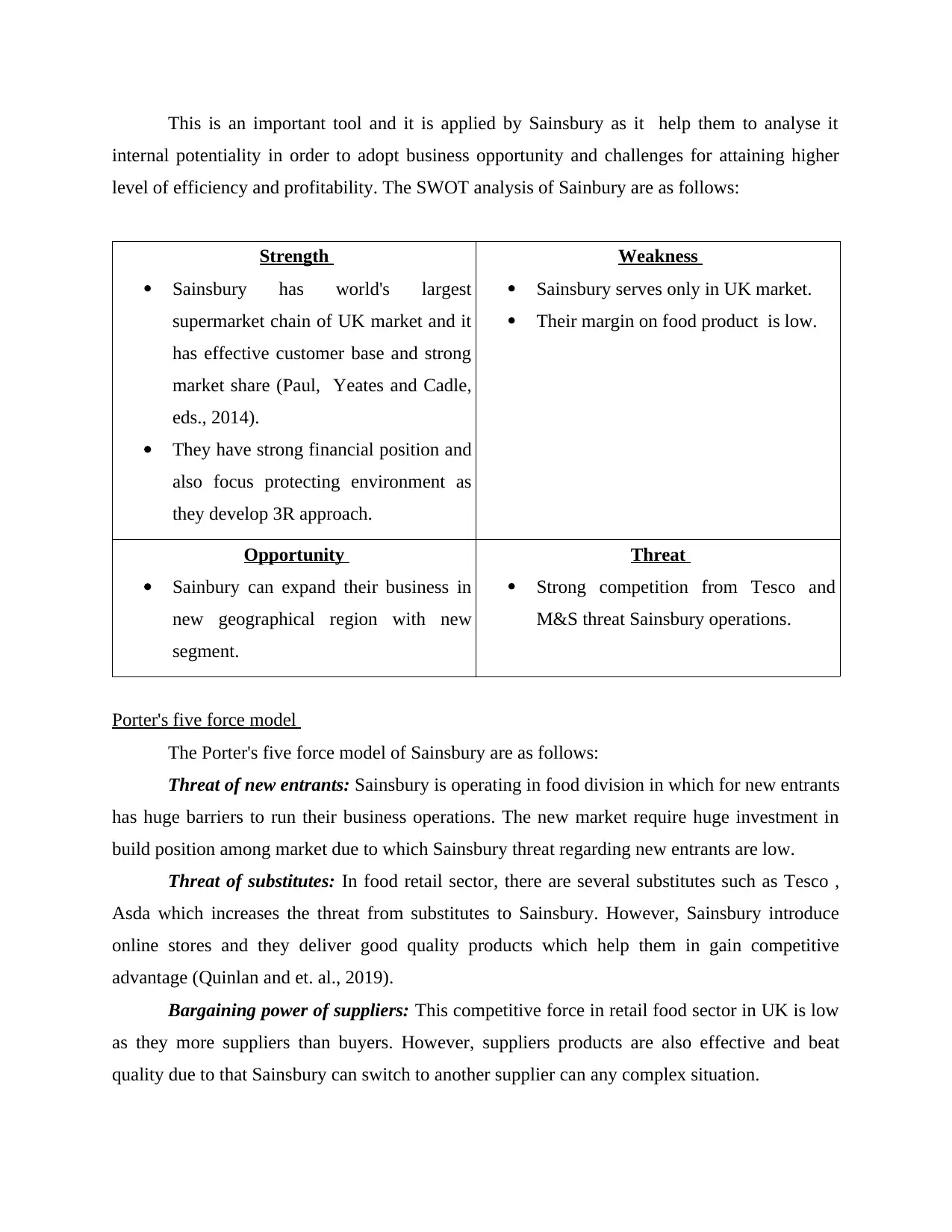
This is an important tool and it is applied by Sainsbury as it help them to analyse it
internal potentiality in order to adopt business opportunity and challenges for attaining higher
level of efficiency and profitability. The SWOT analysis of Sainbury are as follows:
Strength
Sainsbury has world's largest
supermarket chain of UK market and it
has effective customer base and strong
market share (Paul, Yeates and Cadle,
eds., 2014).
They have strong financial position and
also focus protecting environment as
they develop 3R approach.
Weakness
Sainsbury serves only in UK market.
Their margin on food product is low.
Opportunity
Sainbury can expand their business in
new geographical region with new
segment.
Threat
Strong competition from Tesco and
M&S threat Sainsbury operations.
Porter's five force model
The Porter's five force model of Sainsbury are as follows:
Threat of new entrants: Sainsbury is operating in food division in which for new entrants
has huge barriers to run their business operations. The new market require huge investment in
build position among market due to which Sainsbury threat regarding new entrants are low.
Threat of substitutes: In food retail sector, there are several substitutes such as Tesco ,
Asda which increases the threat from substitutes to Sainsbury. However, Sainsbury introduce
online stores and they deliver good quality products which help them in gain competitive
advantage (Quinlan and et. al., 2019).
Bargaining power of suppliers: This competitive force in retail food sector in UK is low
as they more suppliers than buyers. However, suppliers products are also effective and beat
quality due to that Sainsbury can switch to another supplier can any complex situation.
internal potentiality in order to adopt business opportunity and challenges for attaining higher
level of efficiency and profitability. The SWOT analysis of Sainbury are as follows:
Strength
Sainsbury has world's largest
supermarket chain of UK market and it
has effective customer base and strong
market share (Paul, Yeates and Cadle,
eds., 2014).
They have strong financial position and
also focus protecting environment as
they develop 3R approach.
Weakness
Sainsbury serves only in UK market.
Their margin on food product is low.
Opportunity
Sainbury can expand their business in
new geographical region with new
segment.
Threat
Strong competition from Tesco and
M&S threat Sainsbury operations.
Porter's five force model
The Porter's five force model of Sainsbury are as follows:
Threat of new entrants: Sainsbury is operating in food division in which for new entrants
has huge barriers to run their business operations. The new market require huge investment in
build position among market due to which Sainsbury threat regarding new entrants are low.
Threat of substitutes: In food retail sector, there are several substitutes such as Tesco ,
Asda which increases the threat from substitutes to Sainsbury. However, Sainsbury introduce
online stores and they deliver good quality products which help them in gain competitive
advantage (Quinlan and et. al., 2019).
Bargaining power of suppliers: This competitive force in retail food sector in UK is low
as they more suppliers than buyers. However, suppliers products are also effective and beat
quality due to that Sainsbury can switch to another supplier can any complex situation.
⊘ This is a preview!⊘
Do you want full access?
Subscribe today to unlock all pages.

Trusted by 1+ million students worldwide
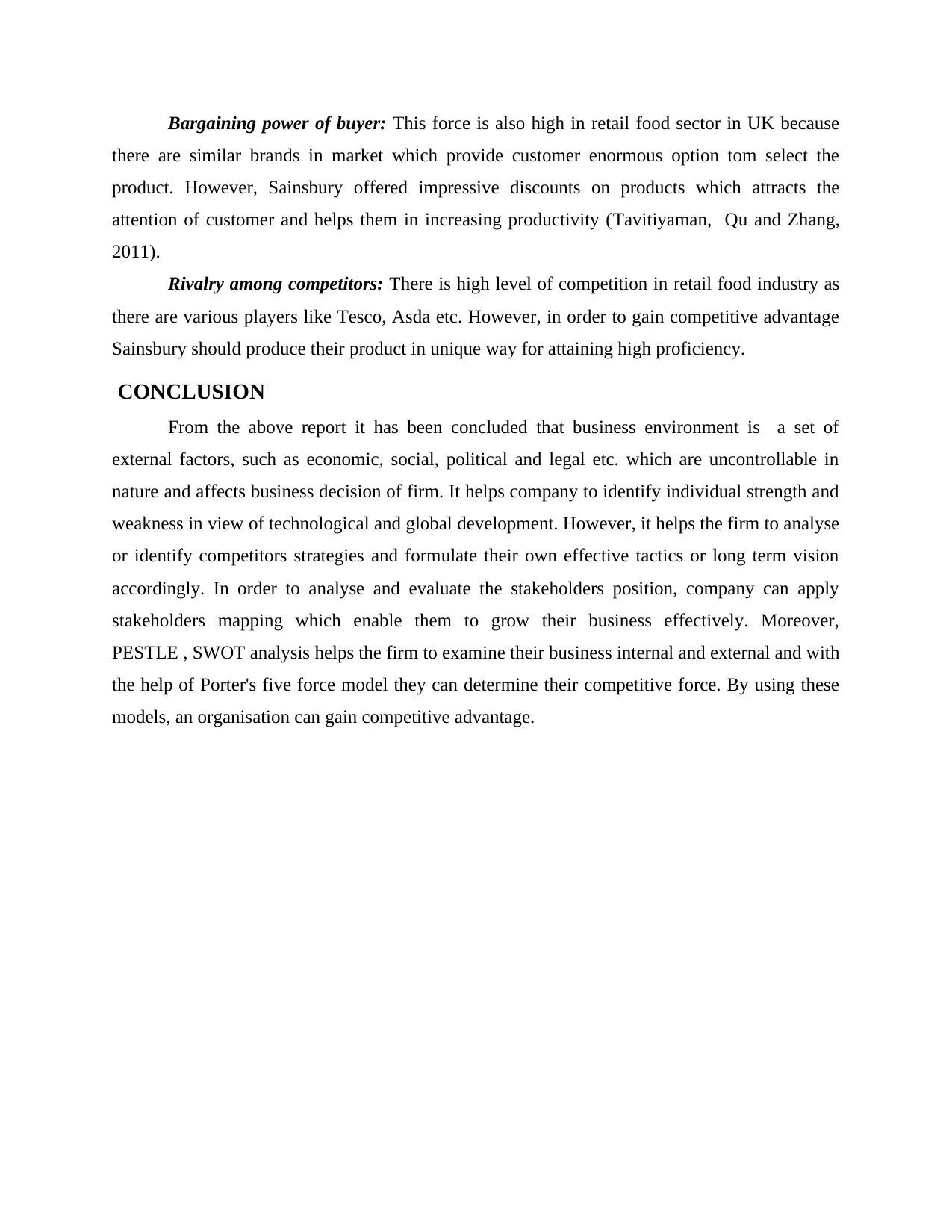
Bargaining power of buyer: This force is also high in retail food sector in UK because
there are similar brands in market which provide customer enormous option tom select the
product. However, Sainsbury offered impressive discounts on products which attracts the
attention of customer and helps them in increasing productivity (Tavitiyaman, Qu and Zhang,
2011).
Rivalry among competitors: There is high level of competition in retail food industry as
there are various players like Tesco, Asda etc. However, in order to gain competitive advantage
Sainsbury should produce their product in unique way for attaining high proficiency.
CONCLUSION
From the above report it has been concluded that business environment is a set of
external factors, such as economic, social, political and legal etc. which are uncontrollable in
nature and affects business decision of firm. It helps company to identify individual strength and
weakness in view of technological and global development. However, it helps the firm to analyse
or identify competitors strategies and formulate their own effective tactics or long term vision
accordingly. In order to analyse and evaluate the stakeholders position, company can apply
stakeholders mapping which enable them to grow their business effectively. Moreover,
PESTLE , SWOT analysis helps the firm to examine their business internal and external and with
the help of Porter's five force model they can determine their competitive force. By using these
models, an organisation can gain competitive advantage.
there are similar brands in market which provide customer enormous option tom select the
product. However, Sainsbury offered impressive discounts on products which attracts the
attention of customer and helps them in increasing productivity (Tavitiyaman, Qu and Zhang,
2011).
Rivalry among competitors: There is high level of competition in retail food industry as
there are various players like Tesco, Asda etc. However, in order to gain competitive advantage
Sainsbury should produce their product in unique way for attaining high proficiency.
CONCLUSION
From the above report it has been concluded that business environment is a set of
external factors, such as economic, social, political and legal etc. which are uncontrollable in
nature and affects business decision of firm. It helps company to identify individual strength and
weakness in view of technological and global development. However, it helps the firm to analyse
or identify competitors strategies and formulate their own effective tactics or long term vision
accordingly. In order to analyse and evaluate the stakeholders position, company can apply
stakeholders mapping which enable them to grow their business effectively. Moreover,
PESTLE , SWOT analysis helps the firm to examine their business internal and external and with
the help of Porter's five force model they can determine their competitive force. By using these
models, an organisation can gain competitive advantage.
Paraphrase This Document
Need a fresh take? Get an instant paraphrase of this document with our AI Paraphraser
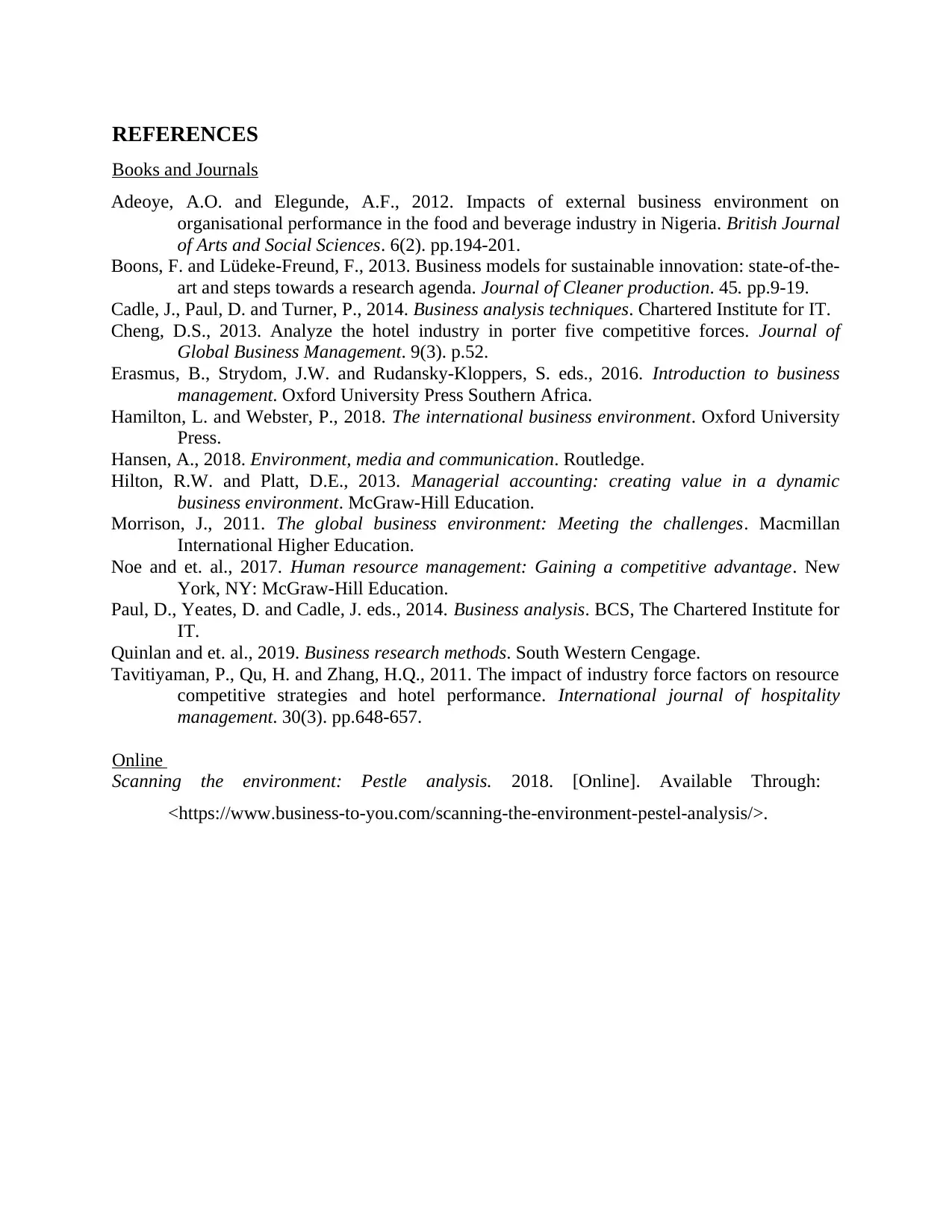
REFERENCES
Books and Journals
Adeoye, A.O. and Elegunde, A.F., 2012. Impacts of external business environment on
organisational performance in the food and beverage industry in Nigeria. British Journal
of Arts and Social Sciences. 6(2). pp.194-201.
Boons, F. and Lüdeke-Freund, F., 2013. Business models for sustainable innovation: state-of-the-
art and steps towards a research agenda. Journal of Cleaner production. 45. pp.9-19.
Cadle, J., Paul, D. and Turner, P., 2014. Business analysis techniques. Chartered Institute for IT.
Cheng, D.S., 2013. Analyze the hotel industry in porter five competitive forces. Journal of
Global Business Management. 9(3). p.52.
Erasmus, B., Strydom, J.W. and Rudansky-Kloppers, S. eds., 2016. Introduction to business
management. Oxford University Press Southern Africa.
Hamilton, L. and Webster, P., 2018. The international business environment. Oxford University
Press.
Hansen, A., 2018. Environment, media and communication. Routledge.
Hilton, R.W. and Platt, D.E., 2013. Managerial accounting: creating value in a dynamic
business environment. McGraw-Hill Education.
Morrison, J., 2011. The global business environment: Meeting the challenges. Macmillan
International Higher Education.
Noe and et. al., 2017. Human resource management: Gaining a competitive advantage. New
York, NY: McGraw-Hill Education.
Paul, D., Yeates, D. and Cadle, J. eds., 2014. Business analysis. BCS, The Chartered Institute for
IT.
Quinlan and et. al., 2019. Business research methods. South Western Cengage.
Tavitiyaman, P., Qu, H. and Zhang, H.Q., 2011. The impact of industry force factors on resource
competitive strategies and hotel performance. International journal of hospitality
management. 30(3). pp.648-657.
Online
Scanning the environment: Pestle analysis. 2018. [Online]. Available Through:
<https://www.business-to-you.com/scanning-the-environment-pestel-analysis/>.
Books and Journals
Adeoye, A.O. and Elegunde, A.F., 2012. Impacts of external business environment on
organisational performance in the food and beverage industry in Nigeria. British Journal
of Arts and Social Sciences. 6(2). pp.194-201.
Boons, F. and Lüdeke-Freund, F., 2013. Business models for sustainable innovation: state-of-the-
art and steps towards a research agenda. Journal of Cleaner production. 45. pp.9-19.
Cadle, J., Paul, D. and Turner, P., 2014. Business analysis techniques. Chartered Institute for IT.
Cheng, D.S., 2013. Analyze the hotel industry in porter five competitive forces. Journal of
Global Business Management. 9(3). p.52.
Erasmus, B., Strydom, J.W. and Rudansky-Kloppers, S. eds., 2016. Introduction to business
management. Oxford University Press Southern Africa.
Hamilton, L. and Webster, P., 2018. The international business environment. Oxford University
Press.
Hansen, A., 2018. Environment, media and communication. Routledge.
Hilton, R.W. and Platt, D.E., 2013. Managerial accounting: creating value in a dynamic
business environment. McGraw-Hill Education.
Morrison, J., 2011. The global business environment: Meeting the challenges. Macmillan
International Higher Education.
Noe and et. al., 2017. Human resource management: Gaining a competitive advantage. New
York, NY: McGraw-Hill Education.
Paul, D., Yeates, D. and Cadle, J. eds., 2014. Business analysis. BCS, The Chartered Institute for
IT.
Quinlan and et. al., 2019. Business research methods. South Western Cengage.
Tavitiyaman, P., Qu, H. and Zhang, H.Q., 2011. The impact of industry force factors on resource
competitive strategies and hotel performance. International journal of hospitality
management. 30(3). pp.648-657.
Online
Scanning the environment: Pestle analysis. 2018. [Online]. Available Through:
<https://www.business-to-you.com/scanning-the-environment-pestel-analysis/>.
1 out of 11
Related Documents
Your All-in-One AI-Powered Toolkit for Academic Success.
+13062052269
info@desklib.com
Available 24*7 on WhatsApp / Email
![[object Object]](/_next/static/media/star-bottom.7253800d.svg)
Unlock your academic potential
Copyright © 2020–2025 A2Z Services. All Rights Reserved. Developed and managed by ZUCOL.





